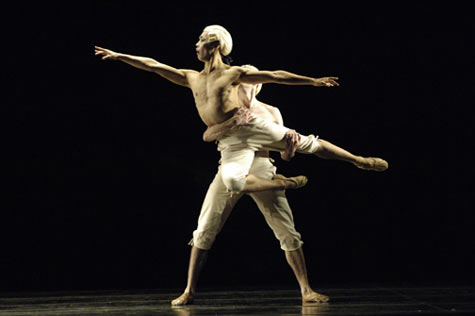
Photo: Eric Antoniou
BOYS WILL BE . . . GIRLS? Altan Dugaraa wonders how he wound up in Pavel Gurevich’s arms.
|
Jiří Kylián’s Black & White
No More Play | Music by Anton Webern | Petite Mort | Music by Wolfgang Amadeus Mozart | Sarabande | Music by Johann Sebastian Bach | Falling Angels | Music by Steve Reich | Sechs Tänze | Music by Wolfgang Amadeus Mozart | Choreography by Jiří Kylián | Presented by Boston Ballet At The Opera House through May 30 PHOTOS:Boston Ballet presents Jiří Kylián’s Black & White |
How do you follow George Balanchine? Try Jirí Kylián. The Czech choreographer/Nederlands Dans Theater director’s genius might be Mannerist to Mr. B’s High Renaissance, but Jirí Kylián’s Black & White, with which Boston Ballet is concluding its 2009–2010 season (at the Opera House though May 30), is, like the “Ultimate Balanchine” program the company just presented, a study in opposites: men and women, sex and death, and all the gray areas in between. Boston Ballet — the only company outside the Netherlands to do the complete Black & White — staged this evening-length quintet of pieces last season, but the density of Kylián’s insights and the intensity of the dancers’ performances prompted artistic director Mikko Nissinen to bring it back.Kylián is not on everybody’s list of favorite contemporary choreographers — perhaps because he exposes too much (and I don’t mean just the nudity in his Bella Figura, which the company will do next season). Some might be more comfortable with Mark Morris’s “Hey, everybody, let’s get metrosexual” approach. But No More Play, Petite Mort, Sarabande, Falling Angels, and Sechs Tänze — which Kylián created between 1986 and 1991 and then turned into the Black & White set — plumb the power politics of sexual identity and sexual relationships. And in Petite Mort and Sechs Tänze, Kylián uses Mozart to far greater effect than Morris does in his Mozart Dances.
It’s all tied together by a group of voluminous (and mostly black — as in mourning?) 18th-century gowns, which, on casters, dart in and out, an emblem of women’s voluptuousness and vulnerability. Set to Anton Webern’s urban-nightmare Five Movements for Strings, No More Play is the prologue: we’re in William Forsythe territory, with three men and two women — almost always in groups of twos and threes — in the twilight of day and perhaps of love. It starts with what looks like an allusion to the “Dark Angel” section of Balanchine’s Serenade; at the end, the quintet close ranks, all five sitting downstage with their backs to us and then laying out, their heads dangling over the stage apron, asking us in and at the same time shutting us out.
What’s to come is, however, almost all play. Petite Mort, to the sumptuous slow movements from Mozart’s K.488 and K.467 piano concertos (the latter familiar from the Swedish film Elvira Madigan), is a flashback: men in gold corset briefs brandishing foils, women on their backs with their legs spread — but is that the cuckold sign they’re making with their hands? In French, “petite mort” is slang for “orgasm,” but the huge black shroud with which the men uncover the women is all about the big death, not the little one, and that’s what hangs over the six sexual-encounter duets, where passion does not mean possession.